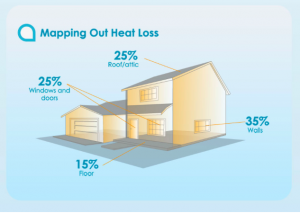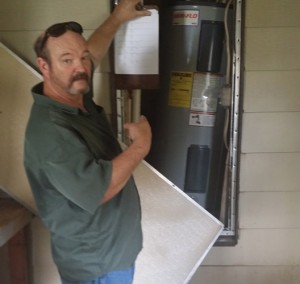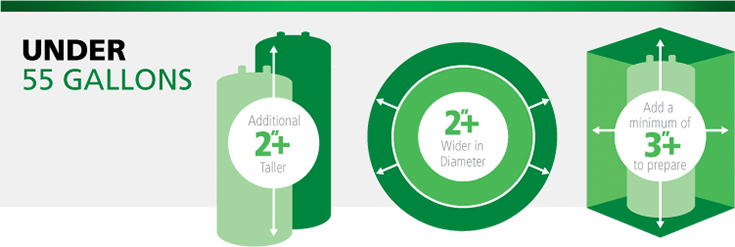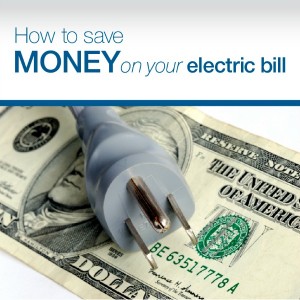
Home Heat Loss
Insulating your attic will help keep your heating and cooling from going through the roof and your wallet. Keep in mind that insulation can compress over time, become less effective and may need to be replaced. Adequate insulation will keep unwanted heat out of your home, reduce the workload on your cooling system and save money on your electric bill.
Grab a ruler or tape measure and a flashlight and go into your attic to measure the depth of the insulation at the attic entry. After measuring, use this guide as a rule-of-thumb to determine if more insulation is needed.
•Fiberglass (paper-backed blankets with the R-value printed on the blanket): less than 3.5 inches
•Fiberglass (pink or white with a loose or coarse texture): less than 5 inches
•Cellulose (gray with a fine soft texture): less than 3 inches
R-value measures resistance to heat flow through a specified thickness of material. The higher the R-value of insulation, the better. According to OUC, “unless the existing insulation is damaged, deteriorated or contaminated with mold or pests, it’s not usually necessary to remove the material before adding more insulation. New cellulose insulation can be installed over existing fiberglass insulation, and new fiberglass insulation can be installed over existing cellulose insulation.”
Most utility companies offer rebates and incentives programs to help cover the cost of installing recommended levels of attic or roof insulation. Typically, the request for rebates must be made within twelve months of installation.
You can use an online zip code insulation calculator such as the one provided by the Department of Energy to determine the recommended attic R-value for your specific region, age of the home, method of heating and home construction. http://web.ornl.gov/sci/roofs+walls/insulation/ins_16.html.
Although you could install insulation yourself with the proper protection and equipment, it’s generally recommended that you hire a licensed contractor who can recommend the type and value of insulation that works best for your home’s age and construction.
Buy Your Side Home Inspections has been inspecting homes and businesses in Central Florida, and specifically Osceola County, for many years. When it comes to serving St. Cloud, Kissimmee, Poinciana, and all of Osceola County, your home inspection satisfaction comes first. We are Buy Your Side every step of the way! For all your inspection needs, call 407.780.0911.
Read More
 This is one more reason why it’s a must to have a home inspector inspect your home before you buy. We call this the leaning heater of p’ana.
This is one more reason why it’s a must to have a home inspector inspect your home before you buy. We call this the leaning heater of p’ana.
Purchasing a home is often the largest investment a family will make in their lives. It’s a very serious decision and commitment and having an adequate amount of information about the house you’re considering is paramount if you want the decision to be a good one.
At Buy Your Side Home Inspections we leave no stone unturned s they say. In the photo in this post you can see that we inspect thoroughly and efficiently… no matter the age of the home!
Read More
 Do you own or live in a home that is more than 30 years old? If so, you may find that the insurance companies you do business with now require an inspection of your home before they will issue you an insurance policy.
Do you own or live in a home that is more than 30 years old? If so, you may find that the insurance companies you do business with now require an inspection of your home before they will issue you an insurance policy.
Osceola county is steeped with numerous older homes that are definitely over 30 years old, so we are often asked to prepare 4-point inspection reports for the owners of such homes. The home’s age at which a 4-point inspection is requested depends on which insurance carrier you are dealing with. More than 30-years old is the threshold in which some companies require an inspection, while others are more lenient and don’t require an inspection until the home is 40 or even 50 years old. One company, Citizen’s Insurance is an example of an insurance company who now requires a four-point inspection for both new policies and renewals of homes or mobile homes that have reached thirty years old.
What I tell people in the community all the time is that i inspect homes as if my momma was moving in… and I mean it. If you’ve been in a home for 25 or 30 years I recommend an inspection. You may not realize a few things. For one, you can save money with some upgrades. Wind mitigation inspections can really save the homeowner money. Insurance companies basically reward homeowners who have correct hurricane protection in their roofing structure. You may or may not meet the requirements that the insurance company asks for… but ether way you want your roof to be adequately sound during the stormy weather we receive in Osceola County.
I also inspect electric and HVAC systems. I see fire hazards everyday in my profession. Remember, I inspect homes like my mama is moving in. I want you to be safe and electrical and HVAC systems after many years can become dangerous, not to mention inefficient. I help people know what they need… not what a sales person says they need.
I inspect the water systems as well… if you have ever seen water damage in a home you know what water damage can do….
So what I am saying is… I am on your side… or as my company says… Buy Your Side! Call me at 407.780.0911 or just contact me here!
Read More
 Today, new energy efficiency standards from the National Appliance Energy Conservation Act (NAECA) go into effect for water heaters. Starting that day, manufacturers will only be allowed to make water heaters that conform to the new energy standards. Existing water heaters will still be allowed to be sold, but I don’t expect that supply to last for more than a few months, and I’ve heard those supplies have already disappeared in some areas. Here’s how the changes will affect homeowners.
Today, new energy efficiency standards from the National Appliance Energy Conservation Act (NAECA) go into effect for water heaters. Starting that day, manufacturers will only be allowed to make water heaters that conform to the new energy standards. Existing water heaters will still be allowed to be sold, but I don’t expect that supply to last for more than a few months, and I’ve heard those supplies have already disappeared in some areas. Here’s how the changes will affect homeowners.
Side note: Don’t call it a “hot water heater.” It’s just a water heater.
Water heaters under 55 gallons will need to have their energy efficiency rating bumped up just a tad. To do this, manufacturers will be adding about an inch of insulation to the water heater tank. This will increase the diameter of same-capacity water heaters by over two inches, and will increase the height by about one to two inches.
This increase in size won’t be a big deal for most people, but if the water heater is squeezed into a tight space, replacing the water heater could be a hassle, or possibly require replacement with a smaller unit. The diagram below is being used with permission from AO Smith.
Gas water heaters over 55 gallons will need to have an energy factor of at least .74 to .75, depending on the exact size. To achieve this modest energy factor increase, it’s expected that manufacturers will only produce condensing water heaters for these larger sizes. That means a powervent water heater, which needs to have its own dedicated exhaust vent, a power source, and a way to dispose of condensate. These water heaters are obviously more expensive, and the installation costs will be higher too.
Electric water heaters over 55 gallons are about to get silly. For these units, the energy factor is going to more than double. To get there, you’ll be looking at a heat pump water heater. Never seen one? I haven’t either.
A heat pump water heater works by extracting heat from the air and transferring it to the water in the tank. Of course, this means it’ll act like an air conditioner in the home. How much will this cool the space it’s in? I don’t know yet, but I’ve heard it’s fairly significant.
It’s important to utilize a Home Inspector that’s on top of technology, inspection regulations and the always changing state and federal laws. Tommy Joynes of Buy Your Side Inspections is trusted, knowledgeable and ready to assist homeowners and homebuyers. Just cal 407.870.0911 or visit www.thefloridainspector.com!
Read More

Is Your Money Going Down the Drain?
Earlier this week we listed seven Hacks to Lower Your Electric Bill. (Read more here: 7 Easy Hacks to Lower Your Electric Bill). Below are 4 Water Guzzlers in your home and tips on how to lower your water consumption. According to the EPA, the average American family of four uses 400 gallons of water per day. On average, approximately 70 percent of that water is used indoors. The biggest culprit is your bathroom toilet, which guzzles about 27 percent of your water consumption. Low flow appliances and fixtures can help to lower that amount by as much as 30% depending on your location.
- Install Water-Saving Toilets: A standard toilet uses 1.6 gallons per flush and much older toilets can use as much as 3.5 to 7 gallons per flush. By installing a water-saving toilet which uses 1.28 gallons per flush or less. a family can reduce the amount of water used for toilets by 20 to 60 percent. By the way, did you know that a running toilet can waste about 200 gallons every day.
- Install a Low-Flow Water Faucet: A bathroom faucet generally runs at 2 gallons per minute. Install a low-flow water faucet and turn off the tap while brushing your teeth or shaving; that alone can save a person more than 200 gallons of water per month.
- Use a High-Efficiency Washing Machine: These washers can conserve large amounts of water. Traditional models use between 27 and 54 gallons of water per load, but new, energy—and water—conserving models (front–loading or top–loading, non-agitator ones) use less than 27 gallons per load.
- Shower Better with Low Flow Shower Heads: A standard shower uses 2.5 gallons per minute and also requires energy to heat the water. By replacing just one shower head with a low-flow fixture, the average family would save 2,900 gallons of water plus the amount of electricity needed to power the home for 13 days, and more than $70 in utility bills.
The EPA recommends WaterSense labels models which are certified to be high performing. They are available in many styles and price points, and some utilities even offer rebates.
You’re not only saving money, but should you decide to sell your home, these features are desirable by most home buyers. When you’re ready for a pre-listing inspection or just want to see how your home measures up, call Buy Your Side Home Inspections – Central Florida’s most-respected home inspection service. 407.780.0911.
Read More

7 Easy Hacks to Lower Your Electrical Bill
Here are 7 easy and relatively inexpensive hacks you can do right now to lower your electric bill every month and not break the bank doing it.
- Turn Off Electric “Vampires”: Devices such as computers, small appliances, televisions, cable boxes, game consoles are sucking up energy even when they are not in use. Group your cords by location in your home and then plug the cords into a power strip that you can easily turn off when you go to bed or leave the home. If that’s too much trouble, programmable power strips are available at hardware stores for a minimal cost.
- Switch Out Those Light Bulbs: Besides turning off lights in rooms when not in use, compact fluorescent lightbulb are slightly more expensive than their regular incandescent counterparts but the return on the investment is huge and they last longer. Can’t afford to do it all at once, change bulbs one room at a time.
- Ditch the Switch and Dim That Light: Besides creating a mood, dimmer switches are easy to install and give you more options for lighting besides on and off. Make sure your dimmer is compatible with your compact fluorescent lightbulb. Newer dimmer switches will actually conserve energy when you’re not lighting the bulb at full capacity. Be sure to turn off the electricity first!
- Switch to Reusable HVAC filters: You’ll save money in the long run because your unit will be more energy efficient and you’ll extend the life of your HVAC system.
- Use Electricity During Off-Peak Hours: You will pay more for electricity during peak times because of the demand. Avoid using appliances and charging your techno gadgets during these hours. If you don’t know what your area’s peak hours are, you can call your local energy provider and ask. The peak hours vary by season, especially here in Florida.
- Use Slow Cookers, Pressure Cookers and Microwaves: The first one is slow and the next two are fast but they all use less energy than your range and oven.
- Get a Programmable Thermostat: You can program these thermostats based on your family’s needs and schedule. They are inexpensive at about $25 and available at your local hardware store.
Having a full Home Inspection done by Buy Your Side Home Inspections will take all the guesswork out of determining the condition of your home. When the inspection is complete, you will be advised of any problems that were discovered and we will discuss solutions or needed actions.
Call Tommy Joynes of Buy Your Side Home Inspections at 407.780.0911 today!
Read More








Follow Us!